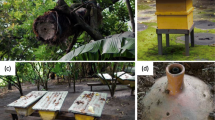Abstract
—The traditional values of caterpillars to the Bisa people of northern Zambia were assessed through a questionnaire survey involving 104 households from 24 villages. Information validation was by Participatory Rural Appraisal, Focus Group Discussions, caterpillar collection and identification. Caterpillars of eight Saturniidae moth species are valued very highly by the Bisa. Six of these were collected and identified from the miombo woodlands of the study area. The harvesting of Gynanisa maja (Klug), Gonimbrasia belina (Westwood), China forda (Westwood), Imbrasia epimethea (Drury), I. rubra (Bouvier) and Imbrasia sp.3 caterpillars by local people, provides an alternative source of dietary animal protein and is associated with several cultural and spiritual processes and beliefs which bind the people together as one tribe. Edible caterpillars are bartered and sold at markets, enabling the local people to gain access to goods and services that normally are out of their reach. An individual collector processed 11.5 kg of sun-dried edible caterpillars worth Zambian Kwacha (ZK) 172,600 (US$ 52) during the caterpillar-harvesting period in 1999, while a household averaging six members processed 69.1 kg caterpillars worth ZK 1,036,098 (US$ 309). The income generated from sales of edible caterpillars far outstripped that generated from the sale of agricultural produce. Estimates of household incomes for 1999, an edible-caterpillar bumper harvest year, and the Bisa traditional edible-caterpillar management system are discussed.
Résumé
—Les valeurs traditionelles des chenilles ont été evaluées chez la tribu Bisa du nord de la Zambie. Pour cela, une enquête sous forme de questionnaire a été conduite chez 104 familles réparties dans 24 villages. Les résultats ont été validés de trios façons: (1) méthode d’“Evaluation Rurale Participative”; (2) méthode de “Discussions avec groupes cibles” et; (3) “échantillonnage et identification des chenilles”. Les résultats montrent que huit espèces de chenilles de la famille des Attacidae ont une très grande valeur chez les Bisa. Six de ces espèces ont été échantillonées et identifiées dans la forêt de type miombo de la localité étudiée. La récolte des chenilles des espèces, Gynanisa maja (Klug), Gonimbrasia belina (Westwood), Cirina forda (Westwood), Imbrasia epimethea (Drury), Imbrasia rubra (Bouvier) et Imbrasia sp.3 constitue sans doute l’une des plus grandes sources de protéines animales du régime alimentaire des Bisa. En outré, cette récolte est associée à plusieurs croyances et pratiques culturelles et spirituelles des Bisa, qui les unissent et tant que membres d’une meme tribu. Sur le plan socio-économique, les chenilles comestibles font l’objet de trocs et sont vendues aux marchés, permettant ainsi à la population de subvenir à ses besoins qu’elle n’est pas à même de se procurer autrement. Au cours de la saison de récolte 1999, un récolteur a préparé 11,5 kg de chenilles comestibles séchées d’une valeur de 172.600 ZK (= 52 dollars américains), tandis qu’une famille des six members en moyenne a préparé 69,10 kg de chenilles pour une valeur de 1.036.098 ZK (= 309 dollars américains). Les revenues provenant de la vente des chenilles comestibles dépassent de loin ceux provenant de la vente des produits agricoles. On discute de l’estimation des revenues en 1999, année de récolte exceptionnelle des chenilles, ainsi que du système traditionnel de gestion des chenilles comestibles par les Bisa.
Similar content being viewed by others
References
Agrawal A. (1995) Indigenous and scientific knowledge: Some critical comments. Indigenous Knowledge and Development Monitor 3, 3–6.
Berkes F., Colding J. and Folke C. (2000) Rediscovery of traditional ecological knowledge as adaptive management. Ecol. Appl. 10, 1251–1262.
[CSO] Central Statistics Office (2001) — National Census Results for the Year 2000. Central Statistics Office, Lusaka.
Cunningham T. (1996) Saturniid subsidy: Cash and protein from edible caterpillars of Zambesian woodlands, pp. 107–108. In The Miombo in Transition: Woodlands and Welfare in Africa (Edited by B. Campbell). Centre for International Forestry Research, Bagor, Indonesia.
De Foliart G. (1989) The human use of insects as food and as animal feed. Entomol. Bull. Entomol. Soc. America 36, 22–35.
De Foliart G. (1990) Insects as food in indigenous populations. Ethnobiology: Implications and applications. Proceedings of the First International Congress of Ethnobiology, Belém 1, 145–150.
De Foliart G. (1991) Insect fatty acids: Similar to those of poultry and fish in their degree of unsaturation, but higher in the polyunsaturates. The Food Insects Newsletter 4, 1–4.
Ferreira A. (1995) Saving the mopane worm—South Africa’s wiggly protein snack in danger. The Food Insect Newsletter 8, 6.
Holden S. T. (1991) Edible caterpillars—a potential agroforestry resource? The Food Insect Newsletter 4, 3–4.
Leleup N. and Daems H. (1969) Les chenilles alimentaires du Kwango. Causes de leur raréfaction et measures préconisées pour y remédier. J. Agric. Trop, Botan. Appl. 16, 1–21.
Lungu P. K. (1999) Community Environmental Action Plan (CEAP) for senior chief Kopa’s chiefdom. Ministry of Tourism, Environment and Natural Resources (MTENR). Lusaka. 26 pp.
Malaisse F. (1997) Se nourrir en forêt claire africaine, approche écologique et nutritionelle. Centre Technique de Coopération Agricole et Rurale, CTA, Wageningen/Les Presses Agronomiques de Gembloux, Gembloux. 384 pp.
Malaisse F. and Parent G. (1980) Les chenilles comestibles du Shaba méridonal (Zaire). Les Naturalistes Belges 61, 2–24.
Morris M. G., Collins N. M., Vane-Wright R. I. and Waage J. (1991) The utilization and value of non-domesticated insects, pp. 319–347. In The Conservation of Insects and Their Habitats (Edited by N. M. Collins and J. A. Thomas). Academic Press, London.
Van Huis A. (1996) The traditional use of arthropods in sub-saharan Africa. Proceedings of the Section Experimental and Applied Entomology of the Netherlands Entomological Society 7, 3–20.
Vane-Wright R. I. (1991) Why not eat insects? Guest editorial. Bull. Entomol. Res. 81, 1–4.
Author information
Authors and Affiliations
Corresponding author
Rights and permissions
About this article
Cite this article
Mbata, K.J., Chidumayo, E.N. Traditional Values of Caterpillars (Insecta: Lepidoptera) Among the Bisa People of Zambia. Int J Trop Insect Sci 23, 341–354 (2003). https://doi.org/10.1017/S1742758400012418
Accepted:
Published:
Issue Date:
DOI: https://doi.org/10.1017/S1742758400012418




